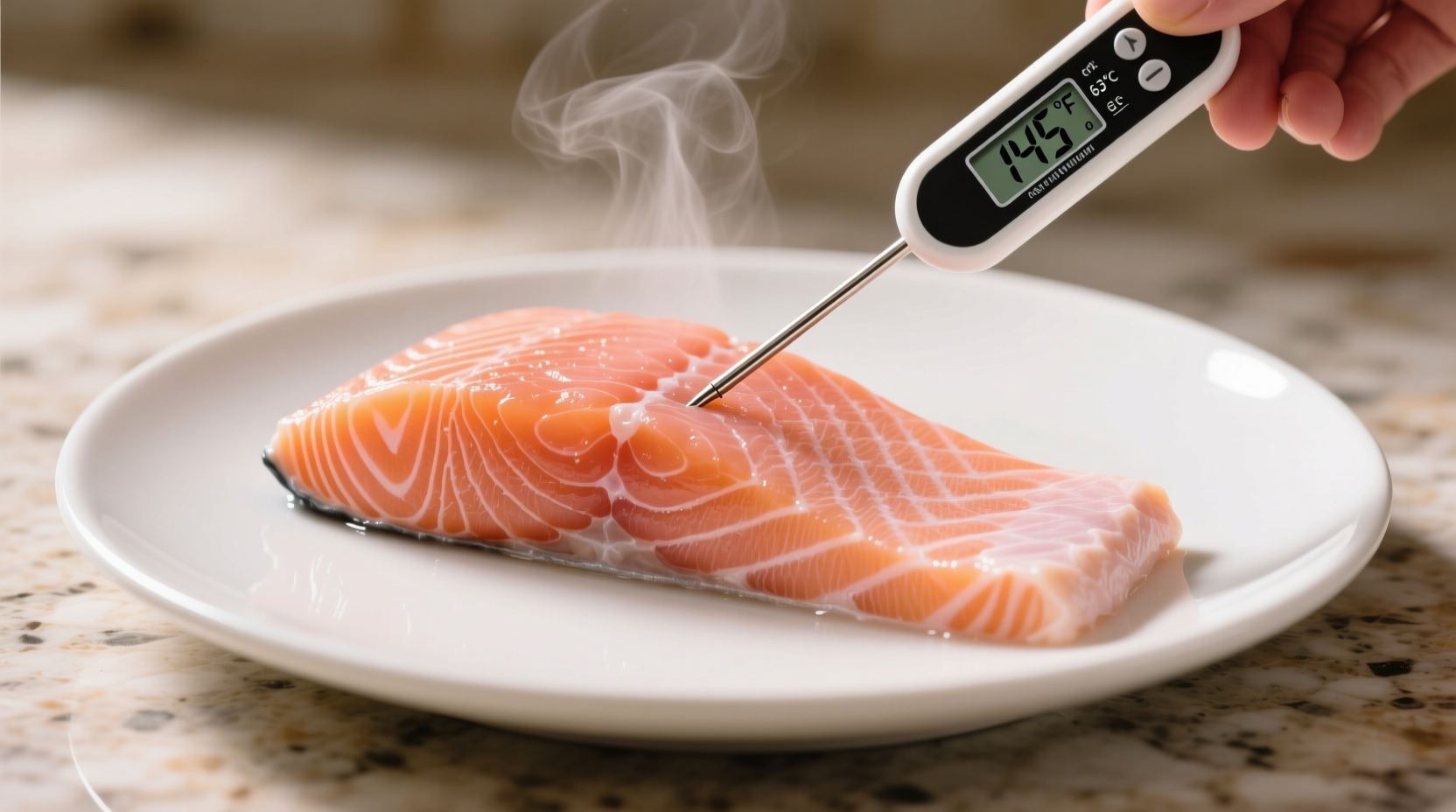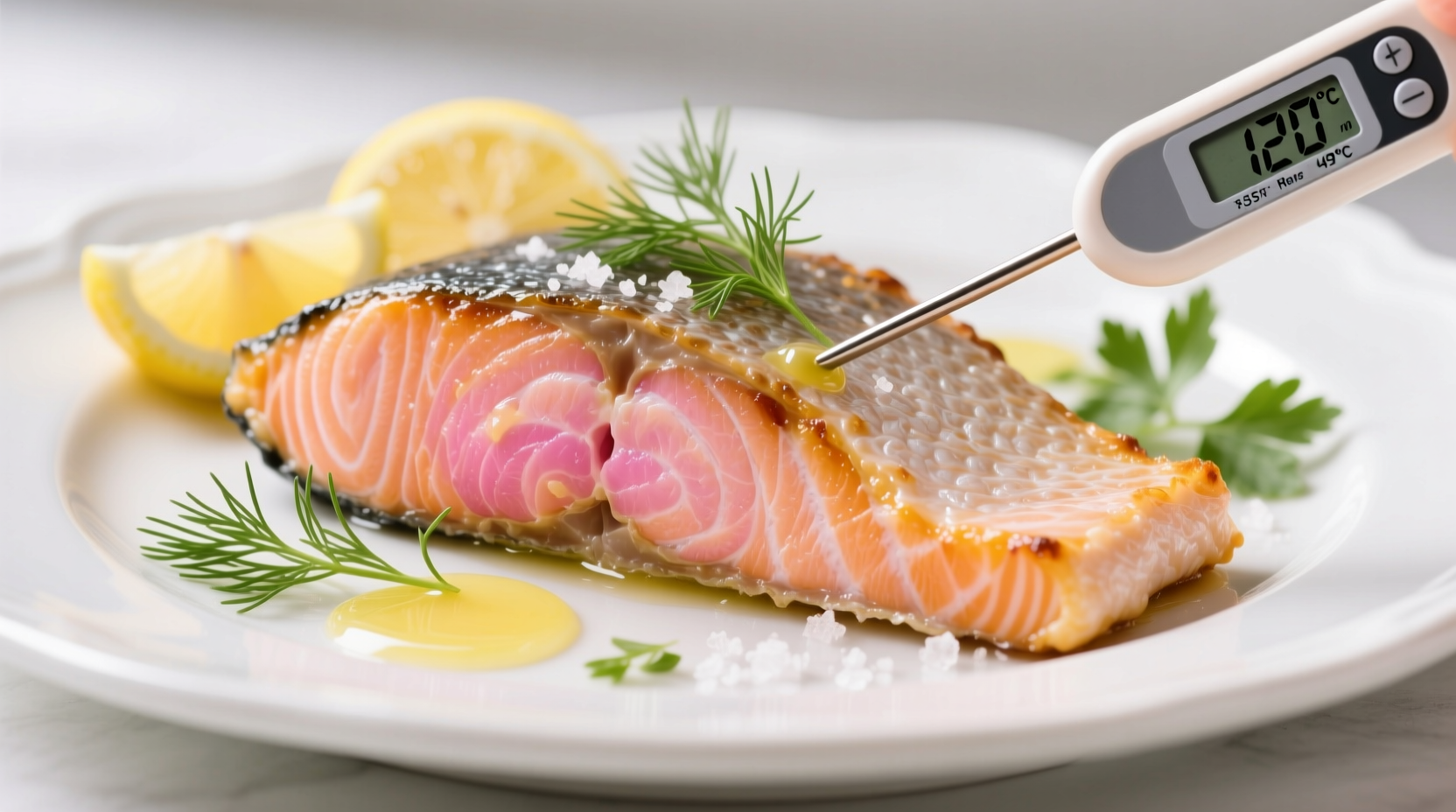Getting salmon perfectly cooked can make the difference between a moist, flavorful meal and dry, unsafe fish. Whether you're a beginner cook or seasoned chef, understanding the precise temperature requirements for salmon eliminates guesswork and prevents foodborne illness. This guide delivers science-backed cooking standards with practical techniques you can implement immediately.
The Science Behind Salmon Cooking Temperatures
When salmon reaches 145°F (63°C), its proteins fully denature, turning the flesh from translucent to opaque while eliminating harmful bacteria like Salmonella and Listeria. Cooking below this temperature risks foodborne illness, while exceeding it causes excessive moisture loss through protein contraction.
Food safety experts at the USDA Food Safety and Inspection Service confirm this temperature threshold through extensive testing. Their research shows that maintaining 145°F for just 15 seconds destroys 99.999% of pathogens commonly found in fish. This standard balances safety with quality—unlike the outdated "flake test" that often leads to overcooking.
| Temperature | Texture | Food Safety | Recommended Use |
|---|---|---|---|
| 120°F (49°C) | Raw, translucent | Unsafe | Sushi-grade only |
| 125-130°F (52-54°C) | Medium-rare, slightly translucent | Risky | Chef-supervised preparation |
| 145°F (63°C) | Firm, opaque, moist | Safe | Standard home cooking |
| 155°F+ (68°C+) | Dry, flaky, crumbly | Safe but overcooked | Avoid for best results |
How to Accurately Measure Salmon Temperature
Proper thermometer placement determines accuracy. Insert an instant-read thermometer horizontally into the thickest part of the fillet, avoiding contact with the pan or plate. Take multiple readings if the piece has uneven thickness.
Remember that salmon continues cooking after removal from heat due to residual heat transfer—a phenomenon called carryover cooking. For best results, remove salmon from heat when it reaches 140°F (60°C), allowing it to coast to the target 145°F (63°C) during resting.

Visual Indicators of Properly Cooked Salmon
While thermometers provide the most reliable measurement, these visual cues confirm proper doneness:
- Color transformation: Flesh changes from deep orange-red to pale pink-orange throughout
- Texture shift: Surface becomes firm to the touch while center remains slightly springy
- Flaking pattern: Gently separates into large, moist flakes when tested with a fork
- Opacity level: No translucent areas remain in the thickest section
These indicators work best when combined with temperature verification, especially for beginners. Experienced cooks develop an eye for the subtle color shift from translucent to opaque that signals perfect doneness.
Safety Considerations for Different Preparation Methods
Certain cooking techniques require special attention to temperature guidelines:
Poaching: Maintain water temperature between 160-180°F (71-82°C). Remove salmon at 140°F (60°C) since water continues transferring heat after removal.
Sous vide: Precise temperature control allows cooking at lower temperatures (125-130°F/52-54°C) for extended periods, but requires strict timing protocols. For home cooks without professional equipment, sticking to the 145°F (63°C) standard remains safest.
Raw preparations: Never serve non-sushi-grade salmon raw. The FDA requires freezing at -4°F (-20°C) for 7 days to kill parasites in fish intended for raw consumption—a process most home freezers cannot achieve.
Avoiding Common Salmon Cooking Mistakes
Many home cooks consistently make these temperature-related errors:
- Mistake: Relying solely on cooking time rather than internal temperature
Solution: Always verify with a thermometer, as thickness and starting temperature vary - Mistake: Testing doneness too early, causing fish to stick to the pan
Solution: Wait until edges turn opaque before checking temperature - Mistake: Ignoring carryover cooking during resting
Solution: Remove from heat source 5°F below target temperature
The American Heart Association confirms properly cooked salmon retains maximum omega-3 fatty acids—overcooking degrades these heart-healthy compounds. Their research shows salmon cooked to 145°F preserves 95% of beneficial fats compared to 78% when cooked to 155°F.
Special Considerations for Vulnerable Populations
Certain groups require strict adherence to the 145°F standard:
- Pregnant women (risk of listeria)
- Children under 5
- Immunocompromised individuals
- Adults over 65
The FDA Food Code specifically states that fish served to these populations must reach 145°F internally. When in doubt, always prioritize safety over texture preferences—properly cooked salmon remains moist when prepared correctly.
Can salmon be safely eaten at 140 degrees?
Salmon reaches food safety standards at 145°F (63°C). While 140°F (60°C) begins the safety zone, the USDA requires 145°F to ensure complete pathogen elimination. Remove salmon from heat at 140°F to allow carryover cooking to reach the safe temperature during resting.
How long should salmon rest after cooking?
Rest salmon for 5-7 minutes after cooking. This allows temperature equalization throughout the fillet and completes the cooking process through carryover heat. Resting also lets proteins relax, retaining maximum moisture.
Does wild salmon require different cooking temperatures than farmed?
Both wild and farmed salmon should reach 145°F (63°C) for safety. Wild salmon typically has less fat, so it may appear done slightly earlier but still requires the same internal temperature verification to ensure safety.
What's the danger of undercooked salmon?
Undercooked salmon (below 145°F) may contain harmful bacteria like Salmonella and parasites such as Anisakis. Symptoms of infection include severe abdominal pain, nausea, and vomiting. The CDC reports increasing cases of fish-borne illnesses from improperly cooked seafood.











 浙公网安备
33010002000092号
浙公网安备
33010002000092号 浙B2-20120091-4
浙B2-20120091-4